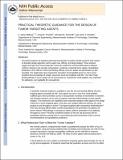| dc.contributor.author | Thurber, Greg M. | |
| dc.contributor.author | Schmidt, Michael M. | |
| dc.contributor.author | Rhoden, John J. | |
| dc.contributor.author | Wittrup, Karl Dane | |
| dc.date.accessioned | 2016-02-29T17:12:17Z | |
| dc.date.available | 2016-02-29T17:12:17Z | |
| dc.date.issued | 2012 | |
| dc.identifier.isbn | 9780123969620 | |
| dc.identifier.issn | 00766879 | |
| dc.identifier.uri | http://hdl.handle.net/1721.1/101376 | |
| dc.description.abstract | Theoretical analyses of targeting agent pharmacokinetics provides specific guidance with respect to desirable design objectives such as agent size, affinity, and target antigen. These analyses suggest that IgG-sized macromolecular constructs exhibit the most favorable balance between systemic clearance and vascular extravasation, resulting in maximal tumor uptake. Quantitative predictions of the effects of dose and binding affinity on tumor uptake and penetration are also provided. The single bolus dose required for saturation of xenografted tumors in mice can be predicted from knowledge of antigen expression level and metabolic half-life. The role of high binding affinity in tumor uptake can be summarized as: essential for small peptides, less important for antibodies, and negligible for nanoparticles. | en_US |
| dc.language.iso | en_US | |
| dc.publisher | Elsevier | en_US |
| dc.relation.isversionof | http://dx.doi.org/10.1016/b978-0-12-396962-0.00010-0 | en_US |
| dc.rights | Creative Commons Attribution-NonCommercial-NoDerivs License | en_US |
| dc.rights.uri | http://creativecommons.org/licenses/by-nc-nd/4.0/ | en_US |
| dc.source | PMC | en_US |
| dc.title | Practical Theoretic Guidance for the Design of Tumor-Targeting Agents | en_US |
| dc.type | Article | en_US |
| dc.identifier.citation | Wittrup, K. Dane, Greg M. Thurber, Michael M. Schmidt, and John J. Rhoden. “Practical Theoretic Guidance for the Design of Tumor-Targeting Agents.” Protein Engineering for Therapeutics, Part B (2012): 255–268. | en_US |
| dc.contributor.department | Massachusetts Institute of Technology. Department of Biological Engineering | en_US |
| dc.contributor.department | Massachusetts Institute of Technology. Department of Chemical Engineering | en_US |
| dc.contributor.department | Koch Institute for Integrative Cancer Research at MIT | en_US |
| dc.contributor.mitauthor | Wittrup, Karl Dane | en_US |
| dc.contributor.mitauthor | Thurber, Greg M. | en_US |
| dc.contributor.mitauthor | Schmidt, Michael M. | en_US |
| dc.contributor.mitauthor | Rhoden, John J. | en_US |
| dc.relation.journal | Protein Engineering for Therapeutics, Part B | en_US |
| dc.eprint.version | Author's final manuscript | en_US |
| dc.type.uri | http://purl.org/eprint/type/JournalArticle | en_US |
| eprint.status | http://purl.org/eprint/status/PeerReviewed | en_US |
| dspace.orderedauthors | Wittrup, K. Dane; Thurber, Greg M.; Schmidt, Michael M.; Rhoden, John J. | en_US |
| dc.identifier.orcid | https://orcid.org/0000-0003-2398-5896 | |
| dc.identifier.orcid | https://orcid.org/0000-0001-7570-2080 | |
| mit.license | PUBLISHER_CC | en_US |
